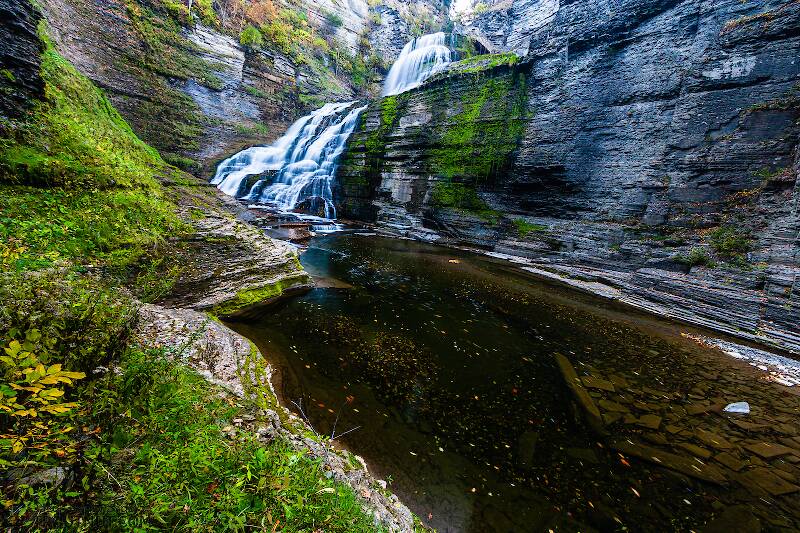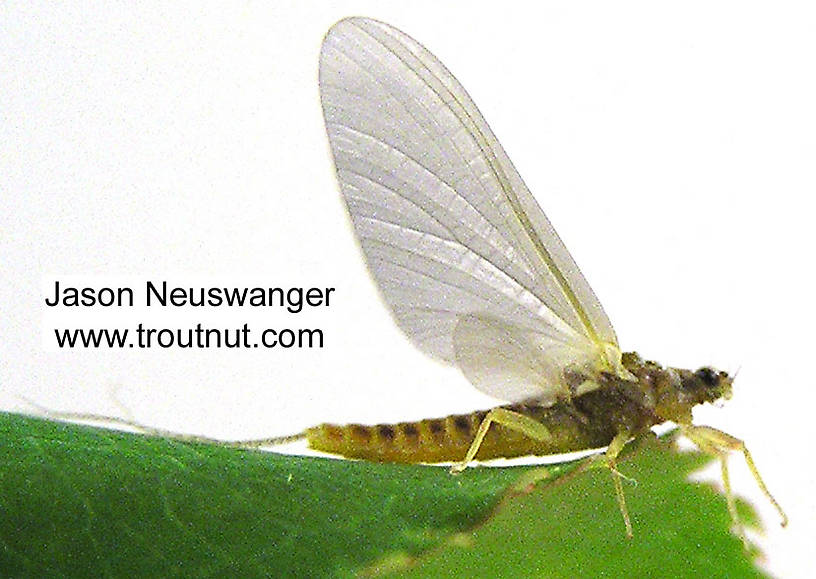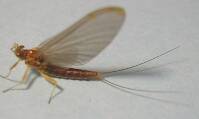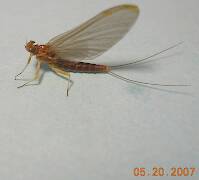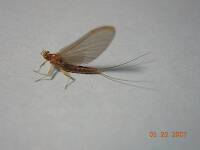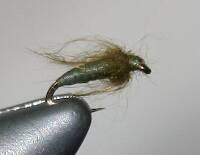
Salmonflies
Pteronarcys californica
The giant Salmonflies of the Western mountains are legendary for their proclivity to elicit consistent dry-fly action and ferocious strikes.
Featured on the forum

This is a striking caddis larva with an interesting color pattern on the head. Here are some characteristics I was able to see under the microscope, but could not easily expose for a picture:
- The prosternal horn is present.
- The mandible is clearly toothed, not formed into a uniform scraper blade.
- The seems to be only 2 major setae on the ventral edge of the hind femur.
- Chloride epithelia seem to be absent from the dorsal side of any abdominal segments.
Based on these characteristics and the ones more easily visible from the pictures, this seems to be Grammotaulius. The key's description of the case is spot-on: "Case cylindrical, made of longitudinally arranged sedge or similar leaves," as is the description of the markings on the head, "Dorsum of head light brownish yellow with numerous discrete, small, dark spots." The spot pattern on the head is a very good match to figure 19.312 of Merritt R.W., Cummins, K.W., and Berg, M.B. (2019). The species ID is based on Grammotaulius betteni being the only species of this genus known in Washington state.
- The prosternal horn is present.
- The mandible is clearly toothed, not formed into a uniform scraper blade.
- The seems to be only 2 major setae on the ventral edge of the hind femur.
- Chloride epithelia seem to be absent from the dorsal side of any abdominal segments.
Based on these characteristics and the ones more easily visible from the pictures, this seems to be Grammotaulius. The key's description of the case is spot-on: "Case cylindrical, made of longitudinally arranged sedge or similar leaves," as is the description of the markings on the head, "Dorsum of head light brownish yellow with numerous discrete, small, dark spots." The spot pattern on the head is a very good match to figure 19.312 of Merritt R.W., Cummins, K.W., and Berg, M.B. (2019). The species ID is based on Grammotaulius betteni being the only species of this genus known in Washington state.

Troutnut is a project started in 2003 by salmonid ecologist Jason "Troutnut" Neuswanger to help anglers and
fly tyers unabashedly embrace the entomological side of the sport. Learn more about Troutnut or
support the project for an enhanced experience here.
Martinlf on Aug 17, 2007August 17th, 2007, 5:43 am EDT
And this one, also from the midwest, is more green than the sulphurs I recall seeing this season. My limited experience in PA streams suggests that many, if not most, of the sulphurs here are best imitated by pale yellow, bright yellow, or orange bodies. Gene, and others, am I far off?
"He spread them a yard and a half. 'And every one that got away is this big.'"
--Fred Chappell
--Fred Chappell
Gene
Posts: 107
Posts: 107
Gene on Aug 21, 2007August 21st, 2007, 7:26 pm EDT
Yes, I believe that the mayfly may be more greenish because of the reflection of green from the leaf during the flash. Sometimes depending upon the angle of the flash the insect will pick up certain colors. You can prove this to yourself by simply get a piece of green paper and reflecting the light onto your hand or face with it. This is what some fly fisherman use to call the "light sulfur." Remember that the pH of the water has a lot to do with color of insects especially mayflies. You are correct that most of the sulfur female bodies are some shade of the colors you suggested. This color will vary with time of year, stream, ph, and a host of other things. That's why I have to laugh sometimes when someone declares in a book that a certain species of insect is this exact color. It's the clearest sign that this person hasn't fished much and is another armchair outdoors man. I would like to know which stream this mayfly was collected from, just for the heck of it.
tight lines and big rising trout
gene
www.limestoner.com
tight lines and big rising trout
gene
www.limestoner.com
Quick Reply
Related Discussions
Topic
Replies
Last Reply
0
May 6, 2011
by Jtberez
by Jtberez
0
Jun 29, 2020
by Wiflyfisher
by Wiflyfisher
11
Aug 29, 2014
by Entoman
by Entoman

